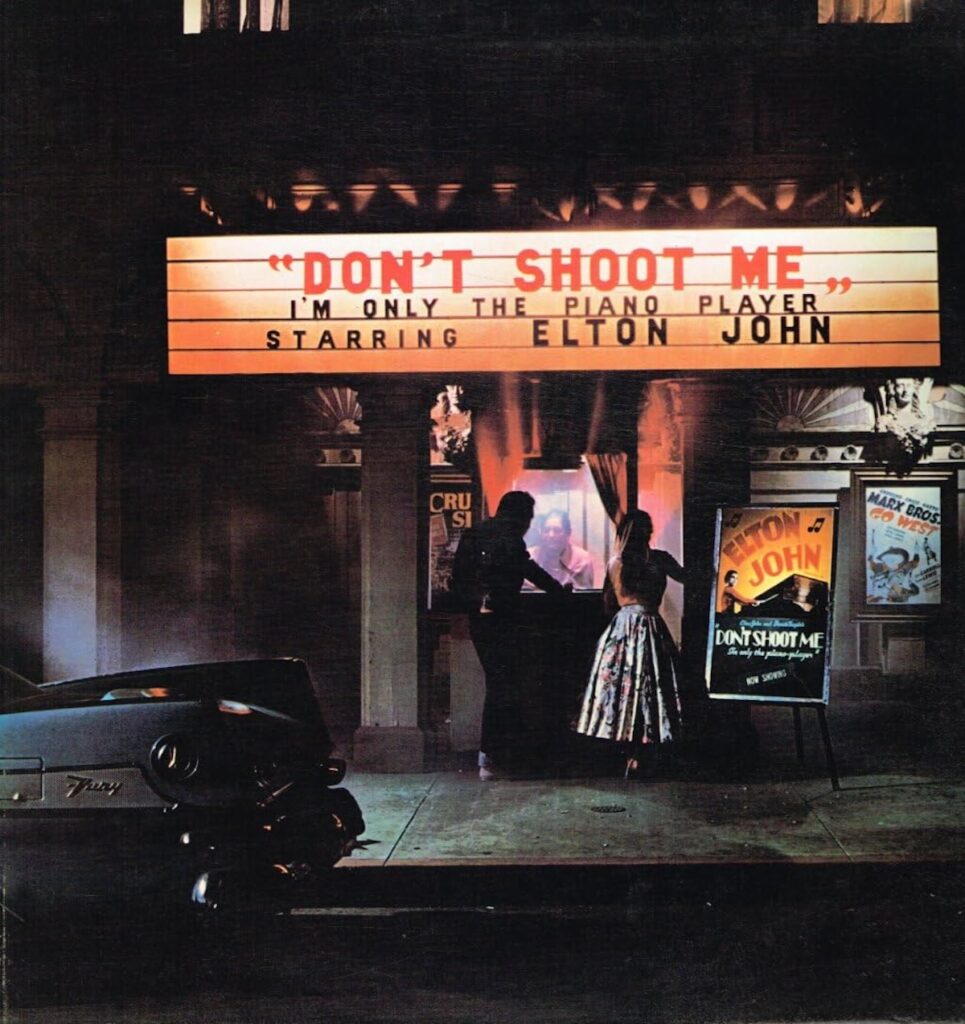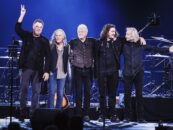Elton John’s ‘Don’t Shoot Me, I’m Only the Piano Player’: A High-Water Mark
by Amy McGrath Still early in his career, but already a bona fide hitmaker, Elton John’s sixth studio album, Don’t Shoot Me, I’m Only the Piano Player, would be the first of two releases—the two-LP Goodbye Yellow Brick Road was released in October—that signaled 1973 as a high-water mark in his burgeoning ascent to superstardom and continued a solid streak of hits that are, to the present day, certified as classics.
Still early in his career, but already a bona fide hitmaker, Elton John’s sixth studio album, Don’t Shoot Me, I’m Only the Piano Player, would be the first of two releases—the two-LP Goodbye Yellow Brick Road was released in October—that signaled 1973 as a high-water mark in his burgeoning ascent to superstardom and continued a solid streak of hits that are, to the present day, certified as classics.
Having come off the #1 success of 1972’s Honky Chateau and simultaneously undertaking a world tour, he traveled back to Château d’Hérouville (then dubbed Strawberry Studios) near Paris in June of that year to begin the sessions for what would become the follow-up to his inaugural chart-topping album.
Once more under the tutelage of producer Gus Dudgeon, John enlisted the talents of guitarist Davey Johnstone, bassist Dee Murray and drummer Nigel Olsson. Only percussionist Ray Cooper was missing, one of the few albums in which he didn’t fully participate, as he was multi-tasking with Joan Armatrading on her debut (also recorded at Strawberry Studios with Dudgeon), Cat Stevens and Cass Elliot, among others. In addition, Dudgeon brought in the horn section that had served John particularly well on the previous album’s Dr. John/Allen Toussaint-flavored single “Honky Cat.”

This photo appeared in the February 24, 1973, issue of Record World.
The 10-song tracklist kicks off with the gentle, laid-back vibe of the Grammy-nominated “Daniel.” While the sands of time have not proven kind in the classification of the genre now dubbed yacht rock, “Daniel” rises above that putdown with its genuine and, in many ways, simplistic and straightforward narrative. Lyricist Bernie Taupin and John have cleared up confusion over the subject matter, due to an entire verse and coda being left off the song: the storyline reflects the emotions of a returning Vietnam vet who is intent on eschewing any and all attention on his return home. Surprisingly, the subdued flute arrangements cascading throughout the tune are not, in fact, an authentic woodwind section. The sounds were produced by John’s programming on the Mellotron, a manufactured effect also familiar from the Beatles’ “Strawberry Fields Forever.”
“Teacher I Need You” is one of those rockabilly throwbacks John does so well. Couched in (maybe) not entirely PC standards—a male student’s crush on a female instructor—for the period in the early ’70s, it has its musical charm. Chief among them is John’s upbeat, confident delivery and the band’s backing vocals that harken to the doo-wop sounds of the ’50s yet are polished to perfection by John’s stellar keyboard work. One can hear the comparisons to John’s fellow and future compadre Billy Joel in his authenticity to capture the environment that Joel was simultaneously pursuing when his breakthrough album Piano Man was released in November of that year.
Prior to Don’t Shoot…’s official release, “Elderberry Wine” was released as the B-side to “Crocodile Rock” in October (U.K.) and November (U.S.) 1972. The song’s structure—John’s trademark rollercoaster phrasing dips from sweet to shouty with peaks of falsetto—coupled with a chewy horn arrangement courtesy of Dudgeon, neatly roll over what unfortunately many consider Taupin’s weakest and silliest lyrics: “How can I ever get it together without a wife in line/To pick the crop and get me hot on elderberry wine?” as an ode for a gentleman whose wife has left him.
“Blues For Baby and Me” begins with one of John’s patented anthemic piano intros and proceeds with the narrator of a dark and uncertain tale wrestling his love away from a hopeless family situation with travel plans for a better future: “There’s a Greyhound outside in the lane, it’s waiting for us/So tell him goodbye, we gotta go west on that bus.” The swinging backbeat with a swaying orchestration and the unexpected inclusion of Johnstone’s precision work on the sitar (!) is firmly rooted in solid storytelling and foreshadows the more complex and personal tone that would color John’s next release only 10 months later.
Side one closes with “Midnight Creeper.” You’d think a tune whose first couple of lines cite Tina Turner and invoke an intended homage to the Rolling Stones would have relevance to the subject matter, but sadly this straight-up rocker is pretty much a stalker song masquerading as a come-on.
Side two opens with “Have Mercy on the Criminal,” which gallops from the get-go and then abruptly shifts downward to a low-key ballad, punctuated by soaring, complementary orchestration from long-time collaborator Paul Buckmaster and a stinging crescendo solo from Johnstone. While it could be compared to the Deep South hymnals prevalent in the ’40s and ’50s, John’s guttural and desperate plea (“Praying Lord you gotta help me/I am never gonna sin again/Just take these chains/From around my legs/Sweet Jesus I′ll be your friend”) is firmly entrenched in the ’60s and ’70s, courtesy of his formative years in his band Bluesology and working with the legendary U.K. vocalist Long John Baldry.
The self-deprecating “I’m Going to Be a Teenage Idol” (dedicated to John’s close friend Marc Bolan of T-Rex) has its moments of hilarity and it’s all due to John’s phrasing, enhanced by a strong horn accompaniment. For the majority of the narrative, John struts and puffs his alleged stardom to the masses, yet manages to poke fun at the whole over-the-top mess with a knowing wink (“Every kid alive gonna know my name/An overnight phenomenon like there’s never been/A motivated supersonic king of the scene”), infused with a sly boy band fandom’s adoration that he and Taupin witnessed in the past, present and, eventually, the future.
Swinging a hard right composition-wise, “Texan Love Song” is a time-travel from present day (read: the U.S. sociopolitical climate), as John brings on an authentic honky-tonk feel and plainclothes performance with minimal instrumentation, aided and abetted by his harmonium and Johnstone’s deft mandolin pluckings. And yet… from a 2025 perspective, this catchy spark of a tune requires close inspection for a viewpoint that may or may not be misconstrued as a combination of racist, misogynistic and brazen foolhardiness in an era when those traits can easily get you cancelled. Or worse.
The album’s pre-release single “Crocodile Rock” has lived many lives and gone through many interpretations, including John’s one-of-a-kind take with Dr. Teeth and the Electric Mayhem on a 1978 episode of The Muppet Show. The core essence of the song seems fairly obvious, as a ‘50s-style paean complete with references to teen sock hops, big-finned Chevys and the forthcoming nostalgia that would dominate the pop culture zeitgeist with American Graffiti. However, John was inspired by the most successful single in Australia up to that point, Daddy Cool’s “Eagle Rock,” a song he heard on tour there and was taken with immediately. Despite its comedic affectation, which rates high on the audience appreciation-o-meter, its Billboard #1 status in addition to its platinum-selling accolades, both John and Taupin have come to view the song as jokey, while stemming off the criticism for its yesteryear leanings. As John stated in an interview for a booklet accompanying the album’s 1995-96 reissue, “I wanted it to be a record about all the things I grew up with. Of course it’s a rip-off, it’s derivative in every sense of the word.”
The original release closes with “High Flying Bird,” a typical time-period LP ender masking as a goodbye to young innocence. As it draws analogies to broken souls departing, John also brings in a deeper meaning as the storytelling author of two star-crossed lovers losing each other by war and death. As John’s pitch-perfect vocals soar over Taupin’s sweet lyrics and a choir of backing voices, it’s hard to not get truly emotional over a four-minute song. John would go on to utilize this over-arching metaphorical and melodic characterization through an entire album with his next release, Goodbye Yellow Brick Road.
Don’t Shoot Me, I’m Only the Piano Player (the title coming from a John performance at a party for comedian Groucho Marx, who continually wound up the pianist and then finger-gestured gun-style, prompting John to exclaim the above) was released on January 22, 1973, in the U.S. and January 26 in the U.K. It was John’s second #1 album on the Billboard 200 and his first on the U.K.’s Official Charts. It also attained the #1 position in Australia, Canada, Italy, Norway and Spain. To date, it has been certified 3x platinum. Four additional tracks were included in a 1995-96 reissue. [The album is available in the U.S. here and in the U.K. here.]
Watch Elton John perform “Crocodile Rock” and “Daniel” live at Madison Square Garden






2 Comments so far
Jump into a conversationElton saying that to Groucho is news to me and I bought the album when it was issued. Still have the original copy.
I always thought the title of this album was a reference to the Truffaut film “Shoot the Piano Player” – but what do I know?
Elton John albums (at least through Goodbye Yellow Brick Road) seemed to alternate regularly between very good and not so good, the best ones being Tumbleweed Connection, Honky Chateau and GYBR. The ones in between had maybe two or three worthy tracks at most. On this album the one song I found memorable was the fine “Blues for Baby and Me.” I got tired of “Daniel” and “Crocodile Rock” ages ago (I preferred the “Elderberry Wine” B-side). Maybe “Daniel” would have sounded better on acoustic piano, the electric piano being so characteristic of the bland Seventies sound.